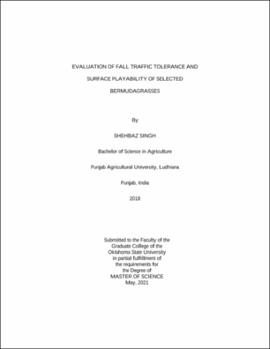| dc.description.abstract | Bermudagrass [Cynodon spp. (L.) Rich.] is the most preferred turfgrass species for athletic fields and golf courses in the southern and transition zones of the United States. It is also extensively used turfgrass species for sod production. Traffic tolerance is an important trait for turf in both the athletics and golf industries. Traffic injury caused by foot or athlete-surface interaction is one of the most critical problems athletic field managers face in maintaining the surface playability and aesthetic quality of sports fields. A 2-year field study was conducted on a Norge loam soil in Stillwater, Oklahoma, to evaluate 9 commercially available and 87 experimental bermudagrasses for fall traffic tolerance, fall color retention, and spring green-up. Twenty-five of these bermudagrasses were also evaluated for sod tensile strength and sod handling quality. Under traffic, 14 experimental and 4 cultivars were in the top statistical group on each date for each variable. Among these entries, 17-5200-4x11, 17-4200-19x9, 'Bimini', 'OKC1134 (NorthBridge), and OSU1664 also showed minimal variation from non-trafficked to trafficked conditions suggesting excellent traffic tolerance. The entries 18-8-1, 17-5200-31x3, an 'U-3-SIU' had excellent fall color retention under non-trafficked conditions, while the entries 18-8-3, 18-9-2, 17-5200-3x23, and 17-5200-4x11 shown excellent fall color retention when trafficked. Excellent spring green-up was demonstrated by entries OSU1609, 'OKC1131' (Tahoma 31), OSU1117, and OSU1638 across both traffic treatments. Simulated traffic stress reduced the shear strength and increased the surface hardness over time potentially due to compaction. Shear strength of 'DT-1' (TifTuf) and Tahoma 31 and surface hardness of NorthBridge were least affected by traffic stress. Simulated traffic stress reduced the fall color retention of all cultivars but enhanced the spring green-up of Astro, Bimini, and TifTuf. Bimini demonstrated the greatest mean sod tensile strength but was not statistically different from 18-7-1, 18-8-4, 18-8-7, NorthBridge, or TifTuf. Pearson's correlation coefficient analysis showed a positive correlation (r=0.62) between sod tensile strength and sod handling quality and a positive correlation (r=0.66) between sod tensile strength and shear strength. The sustainability and surface playability of athletic fields in the transition zone can be enhanced by selecting bermudagrass with good fall traffic tolerance, fall color retention, early spring green-up, and surface playability characteristics. | |
